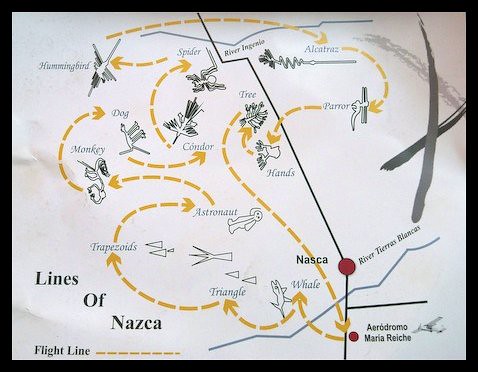Arriving in Lima, Peru. The tourist will find one of the most fascinating and mysterious found also in the south of Lima, this is the city of Ica. For this path we Paracas, Ica, then go through the devastated city of Pisco (that is, takes its name from the renowned drink), here you can still see houses destroyed after the earthquake shaking August 2007.

Photography by funkz
Ballestas Islands:
From a motor boat can move us to the rugged Ballestas Islands, a natural haven from which we can see all types of fauna of the marine ecosystem, including Humboldt penguins, sea lions, pelicans, cormorants and friendly dolphins, spotted the first of the mysterious Nazca lines: The Candlestick.

Photography by archer10 (Dennis)
The chandelier, one can see drawn in the middle of the rock and pointing to the other lines, it is said that this chandelier was used as a guide for navigators, is pointing to the constellation of the Southern Cross, only visible from this hemisphere.
Ballestas Islands, also known locally as «the Galapagos of the poor,» owe their name to the original meaning of the word spring, «cave» or «well» because of the huge caves that formed between them, leaving only step the sea and spectacular sunsets at dusk. Refuge in these islands whose accumulation of seabird guano (droppings) enriches and supplies as the best fertilizer for all crops in the Ica region, famous for its grapes, which become the most popular Peruvian wines and the internationally renowned brandy «pisco.»
Arriving in Nazca:
Once on the road to the town of Nazca, the Andes is slowly transforming the peculiar terrain to begin to shape the mountain tops, in addition to their lunar desert landscape, adorned only by the green valleys of Sacramento and Palpa, these lead us to the corner of archaeological or Nasca Nazca lines (in Quechua), lost in the midst of these mountains, from where you can have a plane fly over the famous Nazca lines, put in a deep cloak of mystery.

Photography by kudumomo
Nazca Lines:
The archaeological discovery is attributed by some sources to the U.S. scientist Paul Kosok, who in 1939 made a flight over the desert and spotted from the air lines with figures carved on the floor representing different forms: a hummingbird, a monkey, a spider, hands, an astronaut … and up to several tens of representations.
The world known as the Nazca Lines, whose origin (attributed to the Nazca culture) is still much debated to this day, extending for 50 kilometers on both sides of the Pan American highway and are visible only from the air. These were declared World Heritage by UNESCO in 1994, mathematics and German archaeologist Maria Reiche (whom the mini Nazca airport is named) spent much of his life studying these curious geoglyphs hidden in the desert whose uncertain origin to this day remains unresolved.

Photography by Ivan Mlinaric
Good luck!
Leave a Reply
You must be logged in to post a comment.
Recent Comments